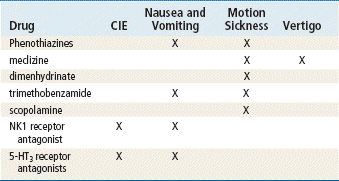http://evolve.elsevier.com/Edmunds/NP/

Other corticosteroids and benzodiazepines may be administered for anticipatory nausea/vomiting associated with chemotherapy. See other relevant chapters.
The mechanisms of action for these first two classes of drugs are not discussed in detail because drugs with similar mechanisms of action can be found in other chapters. The use of these drugs as antiemetics is discussed in this chapter (see Table 30-1).
The phenothiazine subclass of the antidopaminergic antipsychotics includes prochlorperazine and promethazine, which are used for nausea and vomiting. See Chapter 49 for a detailed discussion of the phenothiazine antipsychotics.
The anticholinergics are divided into two subclasses. The antihistamines commonly used as antiemetics are meclizine and dimenhydrinate. See Chapter 15 for a detailed discussion of antihistamines. The other subclass of anticholinergics includes trimethobenzamide and scopolamine. These are similar to other anticholinergics, which are discussed in detail in Chapter 31.
The serotonin 5-hydroxytryptamine3 (5-HT3) receptor antagonists are most useful for the prevention of chemotherapy-induced emesis (CIE) and are discussed in Chapter 31. The prokinetic agent, metoclopramide, is also discussed in Chapter 31.
In all cases of nausea and vomiting or vertigo, the underlying cause should be established because nausea and vomiting are symptoms and are only manifestations of pathophysiologic problems for which further exploration and workup are needed. Severe nausea and vomiting may be the presenting symptoms of underlying conditions such as brain tumor, intestinal obstruction, or appendicitis, and the use of antiemetic medications may slow the diagnosis.
Therapeutic Overview
A “vomiting center” (VC) in the medulla coordinates the respiratory and vasomotor centers and vagus nerve innervation of the GI tract. This center may have four different sources of stimuli. The chemoreceptor trigger zone (CTZ) is located outside the blood-brain barrier near the vomiting center in the medulla (Table 30-2). It communicates with the vomiting center after input is received from drugs and hormones.
TABLE 30-2
Sources of Stimuli to the Vomiting Center
| Source of Stimuli | Type of Stimulus | Receptors Involved |
| GI tract: afferent vagal and splanchnic fibers | Distention, irritation, infection, obstruction, dysmotility | Vagal: 5-HT3 |
| Vestibular system | Motion, infection | Histamine1 (H1) and muscarinic, cholinergic |
| Higher CNS centers | Increased intracranial pressure, infection, tumor, hemorrhage Psychogenic: sights, smells, emotions | Various |
| Chemoreceptor trigger zone (located outside the blood-brain barrier near the medulla) | Drugs such as opioids, chemotherapy, toxins, hypoxia, uremia, acidosis, and radiation therapy | 5-HT3 and dopamine D2 |
Pathophysiology
Normal peristalsis moves the contents of the gut forward. If the forward passage is impeded, reverse peristalsis (retroperistalsis) propels the bolus away from the obstructed segment. During the act of vomiting, retroperistalsis begins in the small intestine. The gastroduodenal junction, stomach wall, and gastroesophageal junction relax to permit passage of the bolus.
Vertigo and motion sickness may require antiemetic treatment. Vertigo is caused by inflammation of the semicircular canals of the inner ear. Motion sickness is caused by repetitive motion, such as angular, linear, or vertical motion.
Disease Process
Nausea is a vague but intensely unpleasant sensation of feeling “sick to the stomach,” “queasy,” or “about to vomit.” This is different from the feelings of discomfort associated with anorexia. Vomiting must be distinguished from the effortless regurgitation that may accompany GERD.
Nausea and vomiting are caused by a wide variety of different factors, ranging from benign fleeting stimuli, such as emotion, to extremely serious disease, such as a brain tumor. Sometimes the cause is obvious, as in motion sickness or reaction to chemotherapy. On other occasions, the diagnosis may be elusive. Accurate diagnosis of the cause also determines which class of antiemetic probably will be most effective.
Motion sickness causes intense nausea and mild vomiting. Patients with vertigo may experience whirling or a feeling of the room spinning around. In true vertigo, the patient can identify the direction in which the room is circling. These patients respond to the sensation with swaying, weakness, and light-headedness. With either of these conditions, the patient may experience sweating, pallor, rapid breathing, and nausea and vomiting.
Mechanism of Action
Antiemetics act on the VC in the medulla through the four different sources of stimuli input. See Table 30-2.
Antidopaminergics
Phenothiazines block D2-dopamine receptors in the CTZ, as well as other areas of the brain. They also have anticholinergic and antihistamine effects. Examples of antidopaminergic agents include the following.
Metoclopramide
Metoclopramide prevents stimulation of the CTZ by antagonizing central and peripheral dopamine receptors and, in higher doses, serotonin receptors. It also accelerates gastric emptying by enhancing the effect of acetylcholine in the upper GI tract.
Anticholinergics
Anticholinergics have antiemetic, anticholinergic, and antihistaminic properties. These antihistamines reduce the sensitivity of the labyrinthine apparatus. This may be mediated through nerve pathways to the VC from the CTZ, peripheral nerve pathways, or other CNS centers. These drugs have a suppressant action on hyperstimulated labyrinthine function. The precise mode of action is not known.
NK1 Receptor Antagonist
Aprepitant is a selective high-affinity antagonist of human substance P/neurokinin 1 (NK1) receptors and the active ingredient of Emend that recently has been approved by the FDA for the prevention of chemotherapy-induced nausea and vomiting (CINV). Early studies led to the development of a nanoparticle formulation that could be used to enhance exposure and minimize food effects; this improves quality of life without increasing adverse effects.
Serotonin 5-HT3 Receptor Antagonists
These are selective inhibitors of type 3 serotonin (5-HT3) receptors that exhibit antiemetic activity. They work peripherally in the intestinal wall by blocking 5-HT3 release from enterochromaffin cells and centrally by blocking 5-HT3 receptors in the CTZ. Current data suggest that serotonin receptors play a major role in acute emesis but only a minor role in delayed nausea and vomiting. Examples of 5-HT3 receptor antagonists include ondansetron HCl, dolasetron, granisetron HCl, and palonosetron (which is available only in an IV formulation).
Stay updated, free articles. Join our Telegram channel

Full access? Get Clinical Tree


 Key drug.
Key drug.
